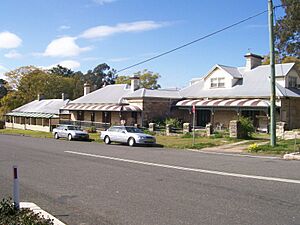East Maitland, New South Wales facts for kids
Quick facts for kids East MaitlandMaitland, New South Wales |
|||||||||||||||
|---|---|---|---|---|---|---|---|---|---|---|---|---|---|---|---|
| Population | 11,860 (2021 census) | ||||||||||||||
| • Density | 744.0/km2 (1,927/sq mi) | ||||||||||||||
| Postcode(s) | 2323 | ||||||||||||||
| Area | 15.94 km2 (6.2 sq mi) | ||||||||||||||
| Location | |||||||||||||||
| LGA(s) | City of Maitland | ||||||||||||||
| Region | Hunter | ||||||||||||||
| State electorate(s) | Maitland | ||||||||||||||
| Federal Division(s) | Hunter | ||||||||||||||
|
|||||||||||||||
East Maitland is a suburb in Maitland, New South Wales, Australia. It's a busy place with important roads and train stations. The New England Highway runs through it. You can also catch a train at Victoria Street or East Maitland stations. Both are served by NSW TrainLink trains. Buses from Hunter Valley Buses also help people get around.
The original people of the Maitland area are the Wonnarua people. They are the traditional owners and caretakers of this land.
Contents
Shopping and Fun
East Maitland has a big shopping area called Green Hills. Here you'll find the large Stockland Green Hills shopping centre. There's also The Pavilion, which has shops like Aldi, Rebel, and Repco. You can also visit the East Maitland Library here.
There are more shops and places to explore near the Victoria Street railway station.
Schools in East Maitland
East Maitland has several schools for different ages. They help students learn and grow:
- St Joseph's Primary School: A Catholic primary school for boys and girls on King Street.
- East Maitland Primary School: A government primary school for boys and girls on William Street.
- Linuwel School: A private school for students from kindergarten to Year 12. It offers an alternative way of learning on Morpeth Street.
- Maitland High School: A government high school for boys and girls on High Street. It used to be only for boys.
- Maitland Grossman High School: Another government high school for boys and girls on Cumberland Street. It used to be only for girls.
The Old Pitnacree Bridge
The Pitnacree Bridge was built in 1866. It helped people cross the Hunter River. The bridge was located on Pitnacree Road. It allowed people to travel from Woodville to East Maitland.
In 1951, a big flood changed the river's path. This meant the bridge was no longer useful. It was taken down in 1962. Today, there's no sign left that it was ever there.
Who Lives Here?
In 2016, about 11,782 people lived in East Maitland. Here are some facts about them:
- About 4.4% of the people were Aboriginal and Torres Strait Islander.
- Most people (85.5%) were born in Australia.
- The next most common countries of birth were England (2.0%) and New Zealand (0.9%).
- Most people (90.2%) spoke only English at home.
- The most common religions were Catholic (26.0%), No Religion (24.6%), and Anglican (22.7%).
Historic Places
East Maitland has many places that are "heritage-listed." This means they are important historical sites. They are protected so future generations can enjoy them.
Some of these special places include:
- 18 Day Street: East Maitland Post Office
- John Street: Maitland Gaol (an old prison)
- 20 John Street: East Maitland Police Station
- 34–40 King Street: 34–40 King Street (a group of historic buildings)
- 42–44 King Street: Goonoobah (a historic home)
- 44 King Street: Woodlands (another historic home)
- Main Northern railway: East Maitland railway station (the train station itself is historic)
- Main Northern railway: Victoria Street railway station (this station is also historic)
- 3 Mill Street: Caroline Chisholm Cottage (a cottage linked to a famous social reformer)
- 91 Newcastle Road: Smith's Flour Mill (an old mill)
- 49 Newcastle Street: Englefield (a historic property)
- 12 Wallis Street: Oldholme (a historic building)
- 47 William Street: St Peter's Anglican Church and Glebe Cemetery (a historic church and graveyard)
A Look Back in Time
The Wonnarua people have lived on this land for thousands of years. They are the traditional owners and have a deep connection to the area.
Around 1818, the first European settlers arrived. Maitland quickly became an important place for trade. It was a key part of the growth of the Hunter Region.
One of the biggest landowners was Tom White Melville Winder. By 1828, he owned a huge amount of land. He later bought even more. His land included parts of what is now the Maitland area.
His "Windermere" estate was very important. It had a large cedar forest. Cedar wood was valuable for building and furniture. Logs were sent down the Hunter River to Sydney and even to England. The Windermere estate was a busy centre for the cedar trade. Winder even had his own boats to move the wood. This estate was set up before East Maitland and West Maitland even existed.
Maitland grew steadily and became a major regional centre in the early colony. Many old buildings in the area show this history. They often used the local cedar wood and sandstone in their construction.
Over time, the way goods were moved changed. Trains and roads became more popular than river travel. Also, the cedar forests were used up. These changes slowed down Maitland's rapid growth. Today, many creeks that were once big enough for boats are now much smaller.
Famous People from East Maitland
Some well-known people have connections to East Maitland:
- Herbert Evatt: A leader of the Australian Labor Party and a judge of the High Court.
- Frederick Lancelot Nott: A person who was a Member of the Queensland Legislative Assembly.
- Les Darcy: A world champion boxer. He is buried in the Catholic part of the East Maitland Cemetery.



